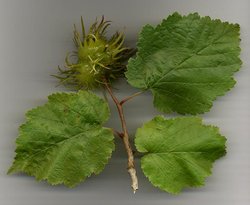Hazel
|
|
This article is about the tree; for other meanings of hazel, see Hazel (disambiguation).
| Hazel | ||||||||||||
|---|---|---|---|---|---|---|---|---|---|---|---|---|
| Missing image Hasel.jpg Flowering Common Hazel in early spring | ||||||||||||
| Scientific classification | ||||||||||||
| ||||||||||||
| Species | ||||||||||||
|
Corylus americana - American Hazel |
The hazels are a genus of about ten species of deciduous trees and large shrubs native to the temperate northern hemisphere. The botanical name is Corylus, and is placed in the family Corylaceae, though some botanists include this family within the Betulaceae. They have simple, rounded leaves with double-serrate margins. The flowers are produced very early in spring before the leaves, and are monoecious, with single-sex catkins, the male pale yellow and 5-12 cm long, the female very small and largely concealed in the buds, with only the bright red 1-3 mm long styles visible. The seeds are nuts 1-2.5 cm long and 1-2 cm diameter, surrounded by an involucre (husk) which partly to fully encloses the nut; the shape and structure of the involucre are important in the identification of the different species of hazel.
The nuts obtained from the Common Hazel (Corylus avellana) are the common edible hazelnuts. This large shrub is grown extensively for its nuts. Nuts are also harvested from some of the other species, including the Filbert, from the closely related Balkan species Corylus maxima.
The Turkish Hazel (C. colurna) is widely cultivated as an ornamental tree in Europe and North America; this species does not conform to the typical stereotype of hazels as being shrubs, instead being a large tree to 35 m tall and with a single straight, stout, trunk up to 1.5 m in diameter. It is very tolerant of difficult growing conditions in urban situations, which has increased its popularity in civic planting schemes in recent decades.
The Common Hazel is also an important component of the hedgerows that were the traditional field boundaries in lowland England. The wood was traditionally grown as coppice, the poles cut being used for wattle-and-daub building and agricultural fencing.
A number of ornamental cultivars of the Common Hazel and Filbert are grown in gardens, including forms with contorted stems (C. avellana 'Contorta', popularly known as "Harry Lauder's walking stick" from its gnarled appearance); with weeping branches (C. avellana 'Pendula'); and with purple leaves (C. maxima 'Purpurea').
Hazels are used as food plants by the larvae of various species of Lepidoptera including Buff Arches, Large Emerald, Pale November Moth, Clouded Border, Dotted Border, Mottled Umber and Light Emerald.
Species
The species are grouped as follows:
- Nut surrounded by a soft, leafy involucre. Multi-stemmed, suckering shrubs to 12m tall.
- Involucre short, about the same length as the nut.
- Corylus americana - American Hazel, from eastern North America
- Corylus avellana - Common Hazel, from Europe, north Africa and west Asia
- Corylus heterophylla - Asian Hazel, from Asia
- Involucre long, twice the length of the nut or more, forming a 'beak'.
- Corylus cornuta - Beaked Hazel, of North America
- Corylus maxima - Filbert, of southeastern Europe and southwest Asia
- Corylus sieboldiana - Asian Beaked Hazel, from northeastern Asia and Japan
- Involucre short, about the same length as the nut.
- Nut surrounded by a stiff, spiny involucre. Single-stemmed trees.
- Involucre moderately spiny and also with glandular hairs. Large trees to 35m tall.
- Corylus colurna - Turkish Hazel, from southeastern Europe and Asia Minor
- Corylus jacquemontii - Jacquemont's Hazel, from the Himalaya
- Corylus chinensis - Chinese Hazel, from West China
- Involucre densely spiny, resembling a chestnut burr. Medium-size trees to 20m tall.
- Corylus ferox - Himalayan Hazel, from the Himalaya.
- Corylus tibetica - Tibetan Hazel, from Tibet and southwest China.
- Involucre moderately spiny and also with glandular hairs. Large trees to 35m tall.
Several hybrids exist, and can occur between species in different sections of the genus, e.g. Corylus x colurnoides (C. avellana x C. colurna).da:Hassel (Corylus) de:Haselnüsse eo:Avelujo pl:Leszczyna

